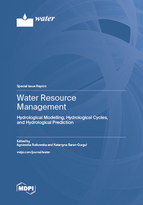Water Resource Management: Hydrological Modelling, Hydrological Cycles, and Hydrological Prediction
A special issue of Water (ISSN 2073-4441). This special issue belongs to the section "Hydrology".
Deadline for manuscript submissions: closed (31 August 2024) | Viewed by 33906
Special Issue Editors
Interests: hydrological time series; nonstationarity detection; statistical methods; hydro-climatic extreme events; temporal and spatial variability; climatic changes impact on hydrological characteristics; anthropogenic impacts on extreme events; drought indices
Special Issues, Collections and Topics in MDPI journals
Interests: applied statistics; hydrological time series; droughts; environmental modeling; statistical methods in hydrology; temporal and spatial variability; river hydrology; geospatial analysis; survey data analysis
Special Issues, Collections and Topics in MDPI journals
Special Issue Information
Dear Colleagues,
I invite you to contribute to the upcoming Special Issue in the open access journal Water, entitled “Water Resource Management: Hydrological Modelling, Hydrological Cycles, and Hydrological Prediction”.
The proper assessment of river flow and precipitation variability, the frequency and severity of extreme events, and the correct development of hydrological prediction become challenging tasks due to climate change and land-use and land cover changes that strongly affect water resources.
The Special Issue offers the opportunity for researchers to share their advances in various topics of water resources management such as:
- The variability of river flow and precipitation characteristics (temporal, spatial, circular);
- The detection of non-stationarity in hydrological and environmental time series;
- Extreme events—floods and droughts; quantitative approach;
- Runoff prediction;
- The assessment of uncertainty in hydrological prediction;
- Associations between hydrological characteristics and climatic indices;
- Links between river flows and human-induced or natural catchment changes;
- The impact of climatic changes on water resources;
- Other topics related to water resources management.
Authors are invited to contribute their original research findings that can help gain more knowledge of the understanding of water resources systems and behaviors. The approaches based on traditional, advanced, and modern statistical and numerical methods are welcome.
Dr. Agnieszka Rutkowska
Guest Editor
Dr. Katarzyna Baran-Gurgul
Guest Editor Assistant
Manuscript Submission Information
Manuscripts should be submitted online at www.mdpi.com by registering and logging in to this website. Once you are registered, click here to go to the submission form. Manuscripts can be submitted until the deadline. All submissions that pass pre-check are peer-reviewed. Accepted papers will be published continuously in the journal (as soon as accepted) and will be listed together on the special issue website. Research articles, review articles as well as short communications are invited. For planned papers, a title and short abstract (about 100 words) can be sent to the Editorial Office for announcement on this website.
Submitted manuscripts should not have been published previously, nor be under consideration for publication elsewhere (except conference proceedings papers). All manuscripts are thoroughly refereed through a single-blind peer-review process. A guide for authors and other relevant information for submission of manuscripts is available on the Instructions for Authors page. Water is an international peer-reviewed open access semimonthly journal published by MDPI.
Please visit the Instructions for Authors page before submitting a manuscript. The Article Processing Charge (APC) for publication in this open access journal is 2600 CHF (Swiss Francs). Submitted papers should be well formatted and use good English. Authors may use MDPI's English editing service prior to publication or during author revisions.
Keywords
- flow characteristics
- hydrological time series
- non-stationarity detection
- hydro-climatic extreme events
- temporal and spatial variability
- climatic indices oscillations
- climatic and anthropogenic impacts
- drought indices
- flood
- droughts
- hydrological hazard
- hazard management
Benefits of Publishing in a Special Issue
- Ease of navigation: Grouping papers by topic helps scholars navigate broad scope journals more efficiently.
- Greater discoverability: Special Issues support the reach and impact of scientific research. Articles in Special Issues are more discoverable and cited more frequently.
- Expansion of research network: Special Issues facilitate connections among authors, fostering scientific collaborations.
- External promotion: Articles in Special Issues are often promoted through the journal's social media, increasing their visibility.
- Reprint: MDPI Books provides the opportunity to republish successful Special Issues in book format, both online and in print.
Further information on MDPI's Special Issue policies can be found here.







